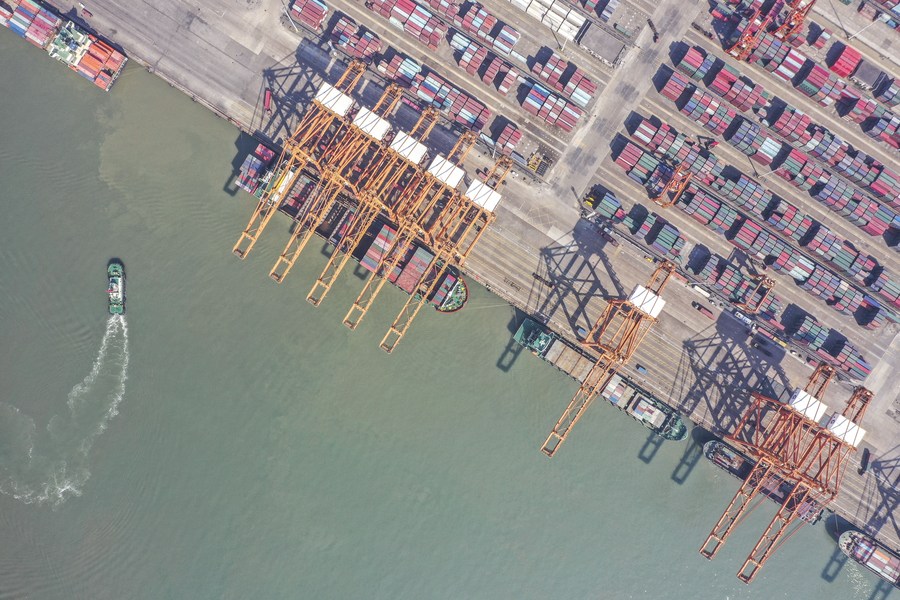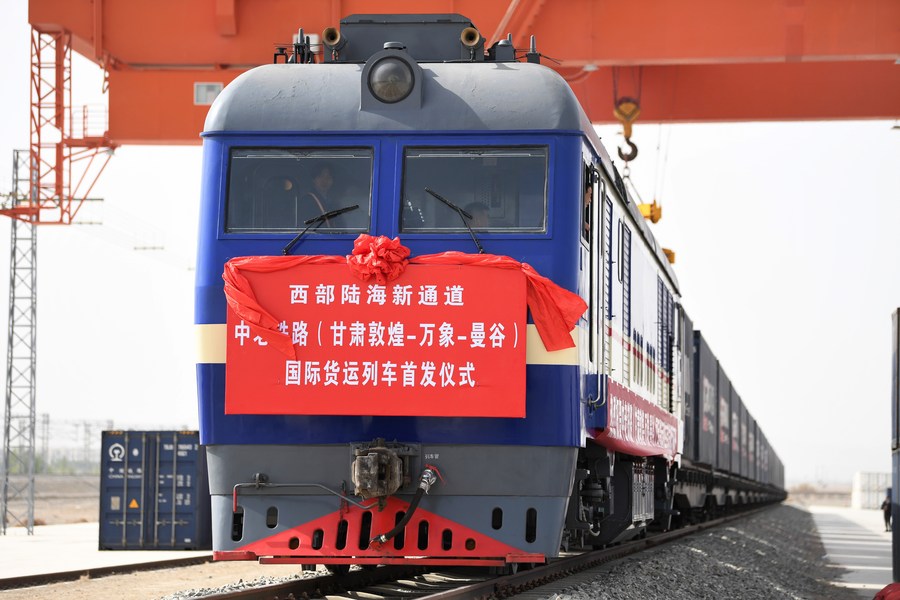Source: Belt and Road Portal

Aerial photo taken on Jan. 14, 2021 shows a view of the container wharf of Qinzhou Port, south China's Guangxi Zhuang Autonomous Region. (Xinhua/Cao Yiming)
As the China-Laos Railway started operation in December 2021 and the Regional Comprehensive Economic Partnership (RCEP) went into effect in January this year, the New International Land-Sea Trade Corridor has been injected with new vitality, energizing high-quality development of the Belt and Road Initiative (BRI).
As of end of April this year, the New International Land-Sea Trade Corridor has expanded its reach to 316 ports in 107 countries and regions, covering 102 domestic stations in 53 Chinese cities of 16 provincial-level regions. Linking with the China-Europe freight train service and the Yangtze River waterway, the trade corridor has been making organic engagement in the development of the BRI.
Jointly built by provincial regions of western China and members of the Association of Southeast Asian Nations (ASEAN), the corridor is an international trade and logistics passage involving railways, waterways and roadways.
By connecting China with the rest of the world through land and sea ports of coastal and border regions such as south China's Guangxi Zhuang Autonomous Region and southwest China's Yunnan Province, the corridor plays an important role in promoting the opening-up of western China, strengthening the incorporation of transportation and logistics in economic development, as well as linking the Silk Road Economic Belt with the 21st Century Maritime Silk Road.
-- Energized by RCEP and vice versa
Since the RCEP went into effect, the New International Land-Sea Trade Corridor has witnessed increasing appeal with boosted freight train services, thanks to policy supports of the trade deal and the joint efforts made by cities and provinces along the route.
Data from the China State Railway Group Co., Ltd. (China Railway) shows that in the first quarter of this year, rail cargo transport through the New International Land-Sea Trade Corridor soared 56.5 percent year on year to 170,000 twenty-foot equivalent unit (TEU) containers, with diversified types of transporting goods and logistics services, as well as newly launched rail-sea transport routes.
Focusing on enhancing cooperation of RCEP implementation, Chinese and Malaysian companies signed investment or strategic cooperation agreements on 11 projects involving cross-border logistics, industries and trade at a forum held in Guangxi on April 26, when Malaysia's Kuantan Port and China's Qinzhou Port agreed to join hands in transforming into key hubs along the New International Land-Sea Trade Corridor.
As the RCEP allows the corridor to give better play to the channel function of southwest China's Sichuan and Chongqing area, the trade deal itself is also benefited from the construction of the New International Land-Sea Trade Corridor, according to Dong Jianguo, director of Chongqing Development and Reform Commission. The city of Chongqing will deepen economic and trade cooperation with ASEAN and strengthen industrial cooperation along the corridor, said Dong.
The New International Land-Sea Trade Corridor is expected to be a carrier of the RCEP, serving as a significant trade vein between the ASEAN and southwest China, said Qiu Dongyang, professor at Chongqing University of Technology. The corridor should facilitate international trade through optimizing transportation, and provide the implementation of RCEP in western China with a logistic passage that is "specific, visible and efficient", said Qiu.
Goods delivered through the corridor have been expanded through the years to more than 640 categories including grain, auto parts, computer accessories, decorative materials, etc., said Lan Jinzong, manager of freight market analysis department of China Railway Nanning Group Co., Ltd. "The New International Land-Sea Trade Corridor has become an important channel connecting western China with the rest of the world, and works as an important engine for the 'dual circulation' of domestic and overseas markets," Lan noted.
-- Expanded through China-Laos Railway
If the New International Land-Sea Trade Corridor is a growing tree, the logistic routes would be the trunks and leaves that guarantee the tree's healthy growth, said Ba Chuanjiang, an official with Chongqing municipal government.
Launched on December 3 last year, the China-Laos Railway adds yet another logistics channel to the corridor network, with a number of new routes started service this year.
For instance, on April 2, a freight train left Nanning, capital of Guangxi for Laos' Vientiane, marking the opening of Guangxi's first international freight train service that runs via the China-Laos Railway; on April 7, the first outbound international rail-sea freight train from China's Yangtze River to Indo-China Peninsula left Guoyuan Port in Chongqing; on April 21, a freight train departed from Dunhuang City of northwest China's Gansu Province for Thailand's Bangkok, marking the opening of the province's first international freight train that runs via the China-Laos Railway.

Gansu's first international freight train that runs via the China-Laos Railway prepares to depart from Dunhuang, northwest China's Gansu Province, April 21, 2022. (Xinhua/Chen Bin)
Data shows that up until the end of March this year, the New International Land-Sea Trade Corridor freight trains have made 38 trips via the China-Laos Railway, carrying 972 TEUs of goods worth more than 200 million yuan (about 29.63 million U.S. dollars) in total and reaching countries including Laos, Thailand, Malaysia and Myanmar.
As one of the operating platforms of the China-Laos Railway, the corridor will strive to forge a demonstration project of railway service contributing to regional economic development, said Wang Yupei, chairman of the New Land-Sea Corridor Operation Chongqing Co., Ltd.
As of May 3, the China-Laos Railway had handled over 2.7 million passenger trips and transported 2.9 million tonnes of cargo since its launch, official data showed. The railway has seen strong growth in cargo transport, with the cargo freight volume in its fifth month of operation hitting 1.1 million tonnes, up 550 percent from its first month of operation, according to China Railway.
-- Supported by "Single Window" platform
In a bid to better serve the New International Land-Sea Trade Corridor and support high-quality development of regional economy, a special service entry for the corridor was launched through the China International Trade Single Portal on April 6, according to the National Office of Port Administration, who guides the construction of the platform.
The platform is jointly built by 14 provincial and municipal regions including Chongqing, Guangxi, Xinjiang, Gansu, Shaanxi, Sichuan, Yunnan, Ningxia, Inner Mongolia, Guizhou, Qinghai, Tibet, Hainan and Guangdong's Zhanjiang City. Featuring the characteristics and demands of the corridor, the platform provides effective customs clearance and logistics facilitating services to relevant enterprises, promoting in-depth incorporation among transportation, logistics, trade and industries.
The platform enables higher efficiency and lower costs in multiple aspects including intelligent customs clearance, logistics collaboration and data application. At the same time, it is also making active efforts to promote unimpeded trade between ASEAN members and the Chongqing-centered area in China. For example, the platform has managed to share eight types of core data with the Port of Singapore Authority International Pte Ltd.
The construction of the platform signals Chongqing's position as the operation center of the New International Land-Sea Trade Corridor, representing the city's determination to proactively participate in the opening-up of western China, Ba Chuanjiang said.